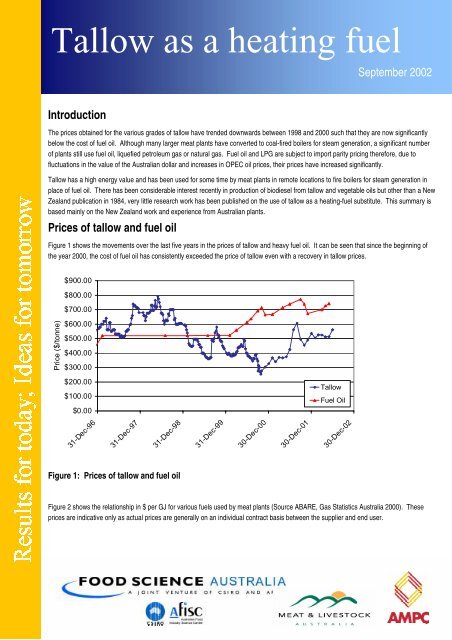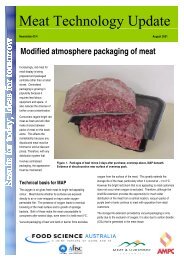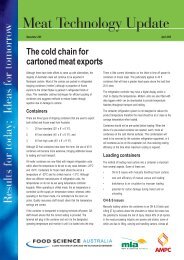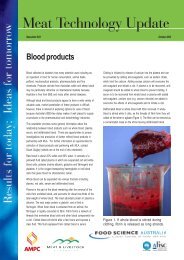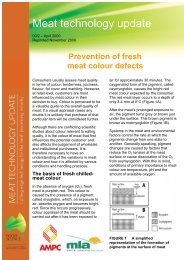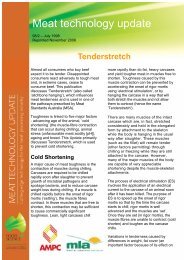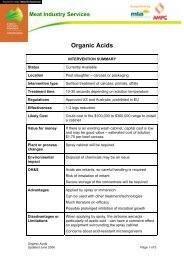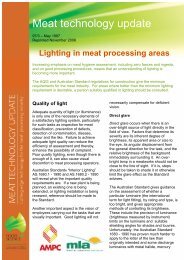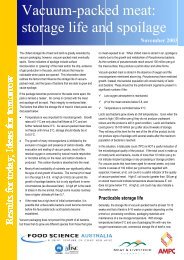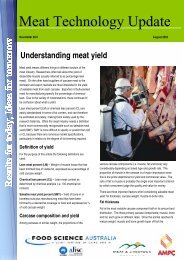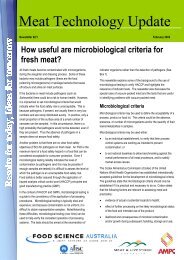Tallow as a heating fuel. - Red Meat Innovation
Tallow as a heating fuel. - Red Meat Innovation
Tallow as a heating fuel. - Red Meat Innovation
Create successful ePaper yourself
Turn your PDF publications into a flip-book with our unique Google optimized e-Paper software.
<strong>Tallow</strong> <strong>as</strong> a <strong>heating</strong> <strong>fuel</strong>September 2002IntroductionThe prices obtained for the various grades of tallow have trended downwards between 1998 and 2000 such that they are now significantlybelow the cost of <strong>fuel</strong> oil. Although many larger meat plants have converted to coal-fired boilers for steam generation, a significant numberof plants still use <strong>fuel</strong> oil, liquefied petroleum g<strong>as</strong> or natural g<strong>as</strong>. Fuel oil and LPG are subject to import parity pricing therefore, due tofluctuations in the value of the Australian dollar and incre<strong>as</strong>es in OPEC oil prices, their prices have incre<strong>as</strong>ed significantly.<strong>Tallow</strong> h<strong>as</strong> a high energy value and h<strong>as</strong> been used for some time by meat plants in remote locations to fire boilers for steam generation inplace of <strong>fuel</strong> oil. There h<strong>as</strong> been considerable interest recently in production of biodiesel from tallow and vegetable oils but other than a NewZealand publication in 1984, very little research work h<strong>as</strong> been published on the use of tallow <strong>as</strong> a <strong>heating</strong>-<strong>fuel</strong> substitute. This summary isb<strong>as</strong>ed mainly on the New Zealand work and experience from Australian plants.Prices of tallow and <strong>fuel</strong> oilFigure 1 shows the movements over the l<strong>as</strong>t five years in the prices of tallow and heavy <strong>fuel</strong> oil. It can be seen that since the beginning ofthe year 2000, the cost of <strong>fuel</strong> oil h<strong>as</strong> consistently exceeded the price of tallow even with a recovery in tallow prices.$900.00$800.00$700.00Price ($/tonne)$600.00$500.00$400.00$300.00$200.00$100.00$0.00<strong>Tallow</strong>Fuel Oil31-Dec-9631-Dec-9731-Dec-9831-Dec-9930-Dec-0030-Dec-0130-Dec-02Figure 1: Prices of tallow and <strong>fuel</strong> oilFigure 2 shows the relationship in $ per GJ for various <strong>fuel</strong>s used by meat plants (Source ABARE, G<strong>as</strong> Statistics Australia 2000). Theseprices are indicative only <strong>as</strong> actual prices are generally on an individual contract b<strong>as</strong>is between the supplier and end user.
252015$/GJ1050Coal Fuel Oil <strong>Tallow</strong> Natural G<strong>as</strong> ElectricityFigure 2: Comparison of energy prices of various <strong>fuel</strong>sProperties of tallow and <strong>fuel</strong> oilTable 1 compares the properties of the commonly used <strong>fuel</strong> oils and tallow.Table 1: Physical and combustion properties of tallow and three grades of <strong>fuel</strong> oil (Spiers, 1955)Diesel Light Fuel Oil Heavy Fuel Oil <strong>Tallow</strong>Ultimate composition (%)CarbonHydrogenSulphurOxygen86.312.80.9086.212.41.4086.111.82.107011019Specific gravity at 15.5ºC 0.830 0.895 0.949 0.920Calorific value (kJ/kg)(kJ/L)45,70039,70044,20039,50043,10040,40040,00036,800Combustion air requirements:kg dry air/kg <strong>fuel</strong>m 3 air/kg <strong>fuel</strong> (0ºC, 760 mm Hg)14.4011.0914.2010.9914.0010.8515.6012.04Composition of wet flue g<strong>as</strong> (%)Carbon dioxide (CO2)Water (H2O)Sulphur dioxide (SO2)Nitrogen (N2)13.412.00.174.513.611.70.174.613.811.30.174.813.913.1073.0Fl<strong>as</strong>h point (ºC) 75.5 79.4 110.0 288 - 316There are several differences between tallow and <strong>fuel</strong> oils. <strong>Tallow</strong> does not contain sulphur, therefore the problem of formation of corrosiveacids from condensation in the stack does not exist. Flue temperature is normally kept above 150ºC with <strong>fuel</strong> oils to prevent condensation.Therefore lower flue temperatures can be used resulting in a net incre<strong>as</strong>e in boiler efficiency.


